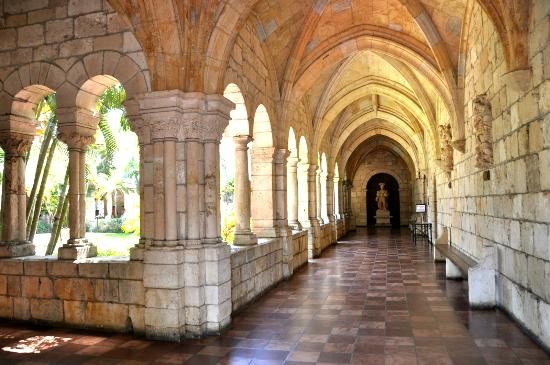Cloisters of the Monastery of Saint Bernard de Clairvaux
Introduction
Text-to-speech Audio
Originally built in Sacramenia in Segovia, Spain from 1133 to 1141 A.D., this medieval structure was purchased by William Randolph Hearst in 1925. Several buildings from the original monastic complex were dismantled, packed in crates, and shipped to the United States. The pieces were stored in a Brooklyn warehouse until 1952, when two businessmen who wanted to reconstruct the monastery purchased them. It took 19 months to piece the Cloisters together again, an effort which Time magazine called “the biggest jigsaw puzzle in history.”
Images
Cloisters of the Monastery of Saint Bernard de Clairvaux

Backstory and Context
Text-to-speech Audio
St. Bernard de Clairvaux Church is a medieval monastery cloister which was originally built in Sacramenia in Segovia, Spain. It was founded by Alfonso VII of Castile and León and built in the Cistercian Romanesque architectural style. Construction on the monastery began in 1133 A.D. and continued until 1141 A.D. It was originally dedicated to the Virgin Mary and named "The Monastery of Our Lady, Queen of the Angels." In 1174, the complex was renamed in honor of Bernard of Clairvaux in honor of his canonization. St. Bernard was a Cistercian monk and mystic who founded and served as abbot of the Abbey of Clairvaux.
For almost 700 years, Cistercian monks occupied the monastery. A fire in 1641 destroyed some parts of the complex, which were subsequently rebuilt. The monastic community remained active until 1835, when the Desamortización resulted in the exclaustration of the inhabitants and the privatization of the main church. The Cloisters were seized, sold, and converted into a granary and stable following a social revolution in the 1830s.
The cloister, chapter house, and refectory of the complex is now located in Miami, Florida; the remainder remains in Sacramenia village. In 1931, the Spanish complex was declared a Spanish national monument. In 1925, William Randolph Hearst purchased the cloister and its outbuildings and had them shipped to the United States. An outbreak of hoof and mouth disease in Segovia led to the quarantine of the 11,000+ crates, which were repacked incorrectly as a result. Owing to Hearst's financial difficulties, the crates remained in a warehouse in Brooklyn, New York.
In 1952, Raymond Moss and William Edgemon purchased the building. Reconstruction began in 1964 on the site of a small plant nursery in Miami. Reassembly cost $1.5 million and took 19 months. Time Magazine called the reconstruction effort “the biggest jigsaw puzzle in history.”1 In 1964, the Cloisters were purchased by Bishop Henry I. Louttit for the Episcopal Diocese of South Florida. They were resold to Colonel Robert Pentland, Jr., who presented them to the Episcopal parish of St. Bernard de Clairvaux.
Some of the decorative elements, such as the carved stone coat of arms, are not original to the structure. The coat of arms belonged to the House of Alburquerque and came from the monastery of San Francisco de Cuella. The chapel dates to the 15th century, initially erected by Beltrán de la Cueva, 1st Duke of Alburquerque.
Today, the Ancient Spanish Monastery is an active parish in the Episcopal Diocese of Southeast Florida, as well as a tourist attraction. English and Spanish services are held on weekdays and on Sundays. Self-guided and private tours of the Cloisters are available on most days. Admission is $10.00 for adults and $5.00 for students and seniors.
For almost 700 years, Cistercian monks occupied the monastery. A fire in 1641 destroyed some parts of the complex, which were subsequently rebuilt. The monastic community remained active until 1835, when the Desamortización resulted in the exclaustration of the inhabitants and the privatization of the main church. The Cloisters were seized, sold, and converted into a granary and stable following a social revolution in the 1830s.
The cloister, chapter house, and refectory of the complex is now located in Miami, Florida; the remainder remains in Sacramenia village. In 1931, the Spanish complex was declared a Spanish national monument. In 1925, William Randolph Hearst purchased the cloister and its outbuildings and had them shipped to the United States. An outbreak of hoof and mouth disease in Segovia led to the quarantine of the 11,000+ crates, which were repacked incorrectly as a result. Owing to Hearst's financial difficulties, the crates remained in a warehouse in Brooklyn, New York.
In 1952, Raymond Moss and William Edgemon purchased the building. Reconstruction began in 1964 on the site of a small plant nursery in Miami. Reassembly cost $1.5 million and took 19 months. Time Magazine called the reconstruction effort “the biggest jigsaw puzzle in history.”1 In 1964, the Cloisters were purchased by Bishop Henry I. Louttit for the Episcopal Diocese of South Florida. They were resold to Colonel Robert Pentland, Jr., who presented them to the Episcopal parish of St. Bernard de Clairvaux.
Some of the decorative elements, such as the carved stone coat of arms, are not original to the structure. The coat of arms belonged to the House of Alburquerque and came from the monastery of San Francisco de Cuella. The chapel dates to the 15th century, initially erected by Beltrán de la Cueva, 1st Duke of Alburquerque.
Today, the Ancient Spanish Monastery is an active parish in the Episcopal Diocese of Southeast Florida, as well as a tourist attraction. English and Spanish services are held on weekdays and on Sundays. Self-guided and private tours of the Cloisters are available on most days. Admission is $10.00 for adults and $5.00 for students and seniors.
Sources
1. "Ancient Spanish Monastery." Ancient Spanish Monastery. Accessed September 9, 2016. http://www.spanishmonastery.com/history.
"St. Bernard De Clairvaux Church." Wikipedia, the Free Encyclopedia. Accessed September 9, 2016. https://en.wikipedia.org/wiki/St._Bernard_de_Clairvaux_Church.
